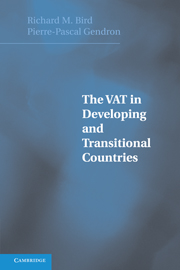Book contents
- Frontmatter
- Contents
- List of Tables
- Preface
- 1 Why This Book?
- 2 The Rise of VAT
- 3 Is VAT Always the Answer?
- 4 Trade and Revenue
- 5 Equity and the Informal Sector
- 6 What Should Be Taxed?
- 7 Key Issues in VAT Design
- 8 New Issues in VAT Design
- 9 Administering VAT
- 10 Dealing with Difficulties
- 11 The Political Economy of VAT
- 12 Where Do We Go from Here?
- Annex
- References
- Index
12 - Where Do We Go from Here?
Published online by Cambridge University Press: 16 November 2009
- Frontmatter
- Contents
- List of Tables
- Preface
- 1 Why This Book?
- 2 The Rise of VAT
- 3 Is VAT Always the Answer?
- 4 Trade and Revenue
- 5 Equity and the Informal Sector
- 6 What Should Be Taxed?
- 7 Key Issues in VAT Design
- 8 New Issues in VAT Design
- 9 Administering VAT
- 10 Dealing with Difficulties
- 11 The Political Economy of VAT
- 12 Where Do We Go from Here?
- Annex
- References
- Index
Summary
The famous Russian author Leo Tolstoy once wrote that all happy families were alike. Most countries with value-added taxes seem relatively happy. But this does not mean that all ‘good’ VATs are alike. And of course not all VATs are equally ‘good.’ By definition, all VATs are value-added taxes in the sense that, as do happy families, they share many important common characteristics. Nonetheless, value-added taxes have a variety of sizes and styles, with different prices attached. No one would expect that a rich person in a cold country looking for the right boots in which to go skiing would buy the same footwear as a poor one in a hot country looking for a little protection for his or her feet. Equally, it seems unlikely that the best VAT for a country like, say, Switzerland – rich, with an excellent tax administration and a solid revenue system – would be the same as that for a country like, say, Liberia – poor, recently emerged from a violent conflict, with few administrative resources and in dreadful fiscal shape. Not only will one size not fit all, but VATs inevitably play different roles in different countries. The right VAT for the moment in any particular country may often be very context-specific.
All this is obvious. Somewhat strangely, however, for decades most developing and transitional countries have been told almost without exception that, so to speak, what is right for Switzerland (or France or Canada) is also right for them.
Information
- Type
- Chapter
- Information
- The VAT in Developing and Transitional Countries , pp. 213 - 222Publisher: Cambridge University PressPrint publication year: 2007
